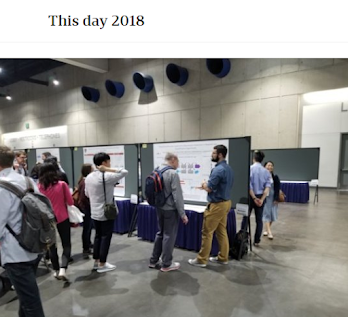I had to cancel ASMS pretty much last minute this year for family things, making it the first year in a lot of years that I haven't been there. My photo storage app keeps popping up cool stuff every day to remind me of how much fun I've had at ASMS over the years with great people that I can't wait to see soon.
When I realized it was really going to be a no go for me, I put out a SOS to one of my very favorite people who is on-site in Mosquitonappolis for the whole thing to keep me and the blog in the loop.
This was his first ASMS poster and abstract during his M.S. a couple of years ago, a photo that popped into my "this day over the years" thing this weekend.
@SpecInformatics will be providing insight into ASMS from the ground to keep me, and this blog in the loop:
Guest blog post day 1:
ASMS 2022: Machine Learning Short Course
Happy 2022 ASMS y’all! It’s the most wonderful time of the year again (even though the last one was only 8 months ago) and I am pumped to see everyone.
Machine learning has been a hot topic that our community is finally fully embracing as an important tool and not just a buzzword that people throw into papers in an attempt to get into a higher impact journal. Many people are familiar with percolator, prosit, and DIA-NN and how big of a contribution to the field they are but what is really going on under the hood? Going through the respective publications, there is a ton of computer science jargon that I expect the average mass spectrometrist can interpret as a foreign language. Now if you're like me and have dipped a toe into this realm it sometimes seems that what you get out of using these tools seems like some magical space wizard took your data and generated some info and figures that will hopefully tell you a really cool story. Want to know more about the spells and incantations that Machine Learning makes on your data? Well this new short course at ASMS 2022 is one you should take!
This is the first year that ASMS is offering a 2 day Machine Learning short course taught by Wout Bittremieux and Will Fondrie and you definitely can’t tell that this is the first time they are teaching this course because it has been on-point. The first part of the class was basically a proverbial Rosetta stone that explained the difference between supervised and unsupervised machine learning, the flexibility of models and how it correlated to bias and variance, how to properly train and test models and what the heck a loss function is. We then moved into Dimensionality reduction. Many of us use PCA plots with colors and circles and say “See! My samples are different!” Well, Are you using them appropriately? When do you want to use other components? Wait, what is a PcoA or t-SNE? Why am I not using them?? This course touched on them all and I definitely need to rethink how I have used them and how I will use them going forward. Day 1 was mainly going over the theory behind each of these methods,the advantages and pitfalls of each and how to appropriately train and test your models. Day 2 is when we really got into it using logistic regressions, support vector machines, random forests and neural networks. Well if that wasn’t exciting enough, Wout and Will made some awesome tutorials online for us to test out and if you are curious yourself, they allowed me to link it here: (https://wfondrie.github.io/2022_asms-ml-short-course/)! We even got a chance to test out if we can train a random forest model on the 2020 ALS challenge that Ben put on. I have been to I think 5 short courses held by ASMS now and I think this is one of the best I have been too and I encourage anyone from any level to attend even just to generate ideas that you can send over to a bioinfomagician and understand the data that you get back. Great start to ASMS and ready for the rest to start!
End guest blog post


No comments:
Post a Comment